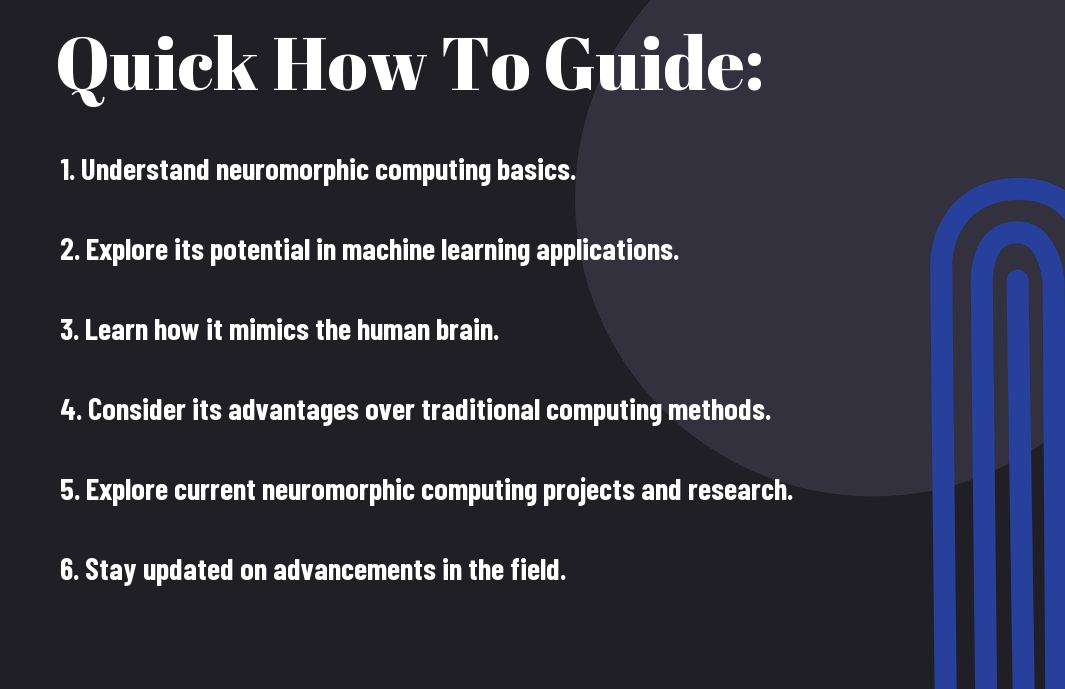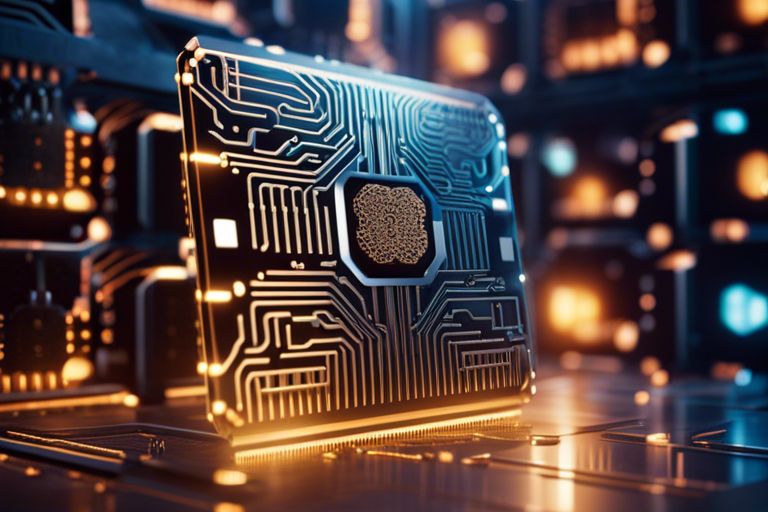Neuromorphic computing is revolutionizing the field of machine learning by mimicking the structure and functionality of the human brain. In this blog post, we will explore how this cutting-edge technology is poised to push the boundaries of artificial intelligence and propel the development of smarter and more efficient algorithms. Join us as we research into the intricate world of neuromorphic computing and its potential to shape the future of machine learning.
Key Takeaways:
- Neuromorphic Computing Enhances Efficiency: Neuromorphic computing offers a more efficient way to process data by mimicking the human brain’s architecture, leading to improved energy efficiency in machine learning applications.
- Advancements in Edge Computing: Neuromorphic computing enables edge devices to handle complex machine learning tasks locally without relying heavily on cloud servers, making real-time data processing more accessible and faster.
- Potential for Cognitive Computing: The development of neuromorphic computing holds great promise in advancing cognitive computing systems, paving the way for machines to perform tasks that require human-like cognitive abilities such as decision making, learning, and adaptation.

Understanding Neuromorphic Computing
What is Neuromorphic Computing?
The field of neuromorphic computing aims to design computer architectures that mimic the neural networks present in the human brain. These architectures are built using memristors and spiking neural networks to replicate the parallel processing, low power consumption, and fault tolerance exhibited by the brain.
Neuromorphic computing imperatively involves using hardware that is specially designed to operate like a human brain. By leveraging the principles of neurobiology, these systems have the potential to revolutionize machine learning algorithms and artificial intelligence applications.
How Does it Differ from Traditional Computing?
If traditional computing is like the way a conventional electronic computer processes information through binary logic gates, then neuromorphic computing is akin to how the human brain works by processing information simultaneously across a vast network of interconnected neurons.
Plus, neuromorphic computing has the advantage of being able to adapt and learn from data in real-time, leading to more efficient and dynamic decision-making processes compared to traditional computing systems.
The Connection Between Neuromorphic Computing and Machine Learning
How Neuromorphic Computing Can Enhance Machine Learning
Machine learning algorithms often struggle with large-scale, complex datasets and real-time processing requirements. Neuromorphic computing offers a promising solution by mimicking the brain’s architecture, enabling more efficient processing of massive amounts of data. By using hardware that is specifically designed to accelerate neural network computations, neuromorphic computing can enhance machine learning tasks such as pattern recognition, natural language processing, and computer vision.
The Role of Artificial Neural Networks in Machine Learning
Artificial neural networks (ANNs) play a significant role in machine learning, serving as the backbone for various deep learning models. These networks are inspired by the structure and function of the human brain, consisting of interconnected nodes that work together to process and learn from data. ANNs are capable of automatically discovering patterns and insights from complex datasets, making them ideal for tasks such as image and speech recognition, recommendation systems, and autonomous driving.
Connection: Artificial neural networks are a fundamental component of neuromorphic computing, as they form the basis for modeling intelligence in machines. By incorporating ANN principles into neuromorphic hardware design, researchers can create more efficient and powerful systems for advancing machine learning algorithms.

How to Implement Neuromorphic Computing in Machine Learning
Not sure how to implement neuromorphic computing in machine learning? If you’re wondering where to start, you can begin by understanding What Is Neuromorphic Computing?
Tips for Designing Neuromorphic Systems
- Consider the use of spiking neural networks to mimic the brain’s neural activity.
- Opt for low-power consumption and high parallelism when designing neuromorphic systems.
Assume that incorporating biological inspirations in the design can lead to more efficient and effective neuromorphic systems.
Factors to Consider When Building Neuromorphic Chips
- Ensure that the architecture is scalable and adaptable to different tasks.
- Consider the integration of memory and processing units within the chip for improved performance.
Any successful development of neuromorphic chips requires a deep understanding of both neuroscience and computer engineering.
How to Integrate Neuromorphic Computing with Existing Machine Learning Frameworks
While integrating neuromorphic computing with existing machine learning frameworks, it is important to consider the compatibility of algorithms and data formats to ensure seamless integration.
Neuromorphic computing offers a promising approach to revolutionize machine learning by emulating the brain’s neural architecture and processing methods.
Benefits of Neuromorphic Computing in Machine Learning
Improved Processing Speed and Efficiency
Despite the significant advancements in traditional computing methods, neuromorphic computing stands out for its improved processing speed and efficiency. This is achieved through the emulation of the parallel processing capabilities of the human brain, allowing for the execution of multiple tasks simultaneously.
Enhanced Pattern Recognition and Learning Capabilities
Processing information in a way that mirrors the human brain, neuromorphic computing enables enhanced pattern recognition and learning capabilities in machine learning systems. This approach allows for more efficient processing of complex data sets and the ability to adapt and learn from new information in real-time.
With the ability to process data in a way that mimics the brain’s cognitive functions, neuromorphic computing systems can quickly recognize patterns in data and make informed decisions based on this information. This not only improves the accuracy and efficiency of machine learning algorithms but also opens up new possibilities for developing more intelligent and adaptive systems.
Increased Energy Efficiency and Reduced Power Consumption
An important advantage of neuromorphic computing in machine learning is its increased energy efficiency and reduced power consumption compared to traditional computing systems. By leveraging the brain’s energy-efficient mechanisms, neuromorphic architectures are able to perform complex computations while consuming significantly less power.
A more energy-efficient approach to processing data, neuromorphic computing offers a sustainable solution for advancing machine learning technologies without compromising on performance. This not only reduces the environmental impact of computing systems but also lowers operational costs for organizations utilizing these technologies.
Overcoming Challenges in Neuromorphic Computing
After acknowledging the potential of neuromorphic computing, it is important to address the challenges that come with this innovative technology. One major obstacle is the complexity of neuromorphic systems, which can be challenging to design and implement.
How to Address the Complexity of Neuromorphic Systems
Overcoming the complexity of neuromorphic systems requires a multidisciplinary approach involving experts in neuroscience, computer science, and engineering. By collaborating across different fields, researchers can leverage their expertise to design more efficient and scalable neuromorphic architectures.
Strategies for Dealing with Limited Training Data
While neuromorphic computing shows promise in mimicking the brain’s learning abilities, one of the challenges is the scarcity of labeled training data compared to conventional machine learning approaches. Researchers are exploring strategies such as transfer learning and data augmentation to make the most of limited training datasets.
Tips for Mitigating the Risk of Overfitting
A common issue in machine learning, overfitting is a concern in neuromorphic computing as well. To mitigate this risk, researchers can implement strategies such as regularization techniques, dropout layers, and early stopping during training.
- Regularization techniques such as L1 and L2 regularization help prevent overfitting by adding penalty terms to the neural network’s weights.
- Dropout layers randomly deactivate a fraction of neurons during training to improve the model’s generalization capabilities.
Another important consideration in neuromorphic computing is the risk of overfitting, where the model performs well on training data but fails to generalize to unseen data. This can be addressed by carefully tuning hyperparameters, using cross-validation techniques, and monitoring the model’s performance on validation datasets.
Real-World Applications of Neuromorphic Computing in Machine Learning
Image and Speech Recognition
If you consider image and speech recognition, neuromorphic computing has shown fantastic potential. These technologies are crucial in various applications such as autonomous vehicles, surveillance systems, and medical imaging. With the ability to process vast amounts of data in real-time, neuromorphic computing can significantly enhance the accuracy and efficiency of image and speech recognition systems.
Natural Language Processing and Robotics
Computing power plays a critical role in advancing natural language processing and robotics. By leveraging neuromorphic computing, machines can better understand and respond to human language in a more natural and contextually relevant manner. This capability is invaluable in applications like virtual assistants, chatbots, and even autonomous robots.
Natural language processing and robotics are highly complex fields that rely on sophisticated algorithms to interpret and interact with human language and behavior. Neuromorphic computing offers a more biologically inspired approach to these tasks, mimicking the brain’s neural networks for improved learning and adaptation.
Healthcare and Biomedical Research
Neuromorphic computing has significant potential in healthcare and biomedical research, revolutionizing areas ranging from disease diagnosis to drug discovery. The ability of neuromorphic systems to analyze complex biological data rapidly and accurately opens up new possibilities for personalized medicine and precision healthcare.
Healthcare and biomedical research benefit greatly from neuromorphic computing’s ability to model intricate biological processes and systems. By simulating neural networks more akin to the human brain, research in these fields can make breakthroughs that were previously unattainable with traditional computing methods.
Final Words
To wrap up, neuromorphic computing offers a promising approach to advancing machine learning by taking inspiration from the human brain’s neural networks. This innovative technology has the potential to overcome the limitations of traditional computing systems, such as energy efficiency and scalability, making it a key player in the future of artificial intelligence. With continued research and development in the field of neuromorphic computing, we can expect exciting new advancements and applications in machine learning that could revolutionize various industries.
FAQ
Q: What is neuromorphic computing?
A: Neuromorphic computing is a field of study that uses the principles of neuroscience to design and develop computer hardware and software with the aim of mimicking the structure and function of the human brain.
Q: How does neuromorphic computing differ from traditional computing?
A: Neuromorphic computing differs from traditional computing in that it relies on neural networks that are designed to simulate the behavior of the human brain, whereas traditional computing relies on von Neumann architecture.
Q: How is neuromorphic computing related to machine learning?
A: Neuromorphic computing is closely related to machine learning as it offers a more efficient and parallel approach to processing data, which can significantly enhance the performance of machine learning algorithms.
Q: What are the potential advantages of using neuromorphic computing for machine learning?
A: Some potential advantages of using neuromorphic computing for machine learning include improved energy efficiency, faster processing speeds, and the ability to handle large-scale, complex datasets more effectively.
Q: Is neuromorphic computing the key to advancing machine learning?
A: While neuromorphic computing shows great promise in advancing machine learning, it is not the sole solution. It is one of the key technologies that, when combined with other advancements, can help propel machine learning to new heights.